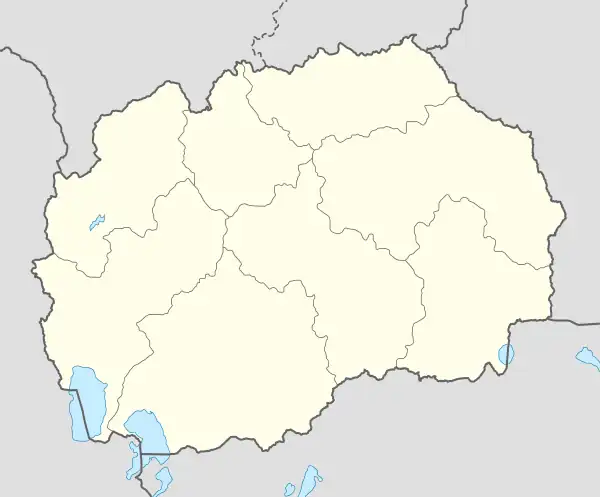Magarevo
Магарево Magarovë Magaruva, Mãgãreva | |
|---|---|
Village | |
 | |
 Magarevo Location within North Macedonia | |
| Coordinates: 41°02′N 21°16′E / 41.033°N 21.267°E | |
| Country | |
| Region | |
| Municipality | |
| Population (2021) | |
| • Total | 81 |
| Time zone | UTC+1 (CET) |
| • Summer (DST) | UTC+2 (CEST) |
| Car plates | BT |
| Website | . |
Magarevo (Macedonian: Магарево; Aromanian: Magaruva or Mãgãreva; Albanian: Magarovë) is a village in the municipality of Bitola, North Macedonia. The village is 8.29 kilometers away from Bitola, which is the second largest city in the country.
History
Magarevo was originally a small village inhabited by a few Orthodox Slavonic families.[1][2] Aromanians settled in Magarevo in addition to Orthodox Albanian refugees who arrived mainly from Vithkuq, fleeing the 18th century socio-political and economic crises in what is now southern Albania.[2] The Albanian population of Magarevo were Tosks, a subgroup of southern Albanians.[3] Due to intermarriage, the Orthodox Albanian population of Magarevo was assimilated by the larger Aromanian community by the onset of the twentieth century.[2]
During the first World War, Magarevo was occupied by the Bulgarian military who evacuated most of the Aromanian villagers and sent them into the interior of Bulgaria and Bulgarian occupation zone of Serbia.[2] The relocation of local Aromanians was due to Bulgarian forces being concerned that pro-Greek and pro-Serbian sympathies existed among them resulting in possible cooperation with the Entente Allies.[2] While in exile, some villagers had to fend for themselves whereas others for the Bulgarians did forced labour.[2] Some Aromanians returning to Magarevo and neighbouring Trnovo saw the level of destruction caused by war in the villages and around 30 families from both settlements crossed the Mariovo mountains on foot into Greece for Aridaia.[2] The Aromanians hoped that their plight and previous service during the Macedonian Struggle for the Greek cause would be recognised by Greece toward eventually re-establishing themselves in Aridaia.[2]
Demographics
In statistics gathered by Vasil Kanchov in 1900, the village of Magarevo was inhabited by 2400 Aromanians.[4]
As of the 2021 census, Magarevo had 81 residents with the following ethnic composition:[5]
- Macedonians 60
- Vlachs 16
- Persons for whom data are taken from administrative sources 3
- Others 2
According to the 2002 census, the village had a total of 87 inhabitants.[6] Ethnic groups in the village include:[6]
- Macedonians 62
- Vlachs (Aromanians) 24
- Others 1
People from Magarevo
- Dimitrios Tsapanos, Greek chieftain of the Macedonian Struggle
- Michail Sapkas, Greek revolutionary and politician
- Dimitrios Lalas, Greek composer and musician
References
- ↑ Турски извори за българската история, БАН, т. VII, София 1986, с. 180.
- 1 2 3 4 5 6 7 8 Koukoudis, Asterios (2003). The Vlachs: Metropolis and Diaspora. Thessaloniki: Zitros Publications. ISBN 9789607760869. p. 352. "Until the Vlachs settled there, Magarevo at least was inhabited by a small number of Slavonic-speaking Christians.... Among the Vlach immigrants there were also a few small groups of Arvanite refugees, mainly from Vithkuq, who settled in Magarevo and Trnovo. By the beginning of the twentieth century, owing to intermarriage with the Vlachs, the Arvanites had ceased to speak Albanian and had been assimilated by the more numerous Vlachs."; pp. 468-469. "The Bulgarians evacuated the inhabitants of... Magarevo... and all these displaced persons (or hostages, one might call them) were relocated to the interior of Bulgaria and Serbia. Some were left to fend for themselves until the end of the war, while others did forced labour for the Bulgarians. The Bulgarians did not relocate all these people for their own safety; their basic motive was to clear the area of the pro-Greek and pro Serbian population groups which might have been inclined to co-operate with the Entente Allies"; p. 470. "Others, seeing the extent of the devastation when they returned to their villages, left for Greece, like a group of thirty or so families from Magarevo and Trnovo, who, having crossed the Morihovo mountains on foot, fled to Aridaia in the hope that the extent of their ruination and, above all, their service during the Macedonian Struggle would be recognised, and that they would eventually be able to re-establish themselves in Aridaia."
- ↑ Indogermanische Gesellschaft (1929). Indogermanisches Jahrbuch, Vol. 13. Karl J. Trübner. p. 183. "Monastir (Bitol) auch für das Studium des Alb. geeignet: Ostrec (11 km von Monastir), Zlokućani haben geg., Dihovo, Bratindol, Magarevo, Ramna, Kažani, Dolenci, Lera, Crnovec, Drevenik, Murgašovo tosk. Bevölkerung. Die tosk."
- ↑ Vasil Kanchov (1900). Macedonia: Ethnography and Statistics. Sofia. p. 239.
- ↑ Total resident population of the Republic of North Macedonia by ethnic affiliation, by settlement, Census 2021
- 1 2 Macedonian Census (2002), Book 5 - Total population according to the Ethnic Affiliation, Mother Tongue and Religion, The State Statistical Office, Skopje, 2002, p. 71.